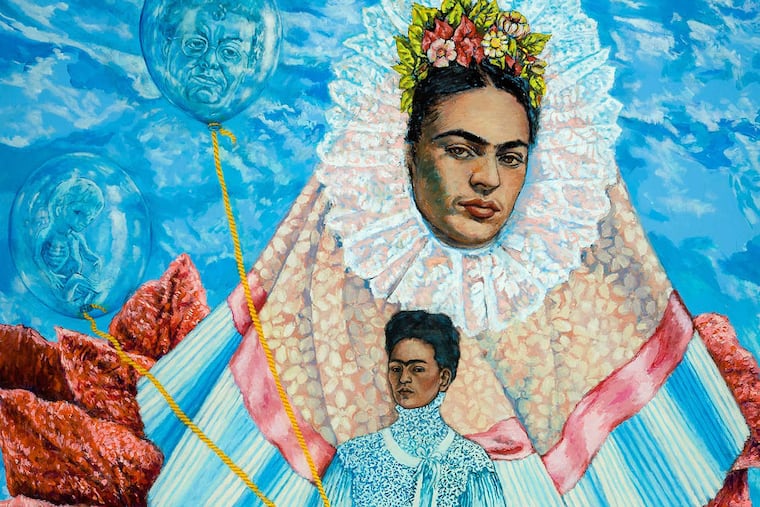Gallery shows: The Sister Chapel at Rowan; 'Brick Moon' at Fjord
Were it not for Andrew Hottle, an art history professor at Rowan University, the quirky 1970s feminist collaboration known as the Sister Chapel would be history.

Were it not for Andrew Hottle, an art history professor at Rowan University, the quirky 1970s feminist collaboration known as the Sister Chapel would be history.
Instead, more than a decade of detective work by Hottle has produced something of an art-world miracle. Not only have all of the paintings by the artists involved in the project been found by Hottle and reunited (and one repainted), they're displayed at Rowan University's Art Gallery West in a fabric-wrapped pavilion that until now had never been realized at its full scale. (In the Sister Chapel's previous installations, at PS1 in Long Island City in 1978, and three other venues between 1978 and 1980, the pavilion, designed by the sculptor Maureen Connor in 1976, was represented by a model and shown near a circle of monumental paintings.)
Conceived in 1974 by the artist Ilse Greenstein as a way to honor women's achievements, the Sister Chapel became the project of Greenstein and 12 other like-minded female artists. Eleven vertical paintings of inspirational women on canvases of the same dimensions (108 by 60 inches) were painted by Alice Neel, Shirley Gorelick, Betty Holliday, June Blum, Martha Edelheit, Diana Kurz, Elsa M. Goldsmith, Cynthia Mailman, May Stevens, Sharon Wybrandts, and Sylvia Sleigh. On exhibit, they would be presented in a circle. Hanging above them, like a ceiling, would be a painting by Greenstein loosely representing dawn and sunset, with a Mylar "mirror" at its center. Connor's fabric structure would form the "chapel."
Now, finally in its completed form, the Sister Chapel is best enjoyed as a whole, a remarkably preserved and improved time capsule.
Neel's 1976 portrait of Bella Abzug, for example, though recognizably a Neel, is not her best work, probably because she used photographs of the congresswoman as her source rather than painting her from life (Abzug was campaigning for a seat in the U.S. Senate at the time). Some other paintings are painfully dated.
The two exceptionally powerful paintings here are Shirley Gorelick's portrait of Frida Kahlo, painted in 1976, which borrows its surreal imagery from several of Kahlo's own self-portraits, and Holliday's 1977 angular and ghostly Marianne Moore, of which Holliday observed, "I've made her whimsical and faintly Mary Poppins-ish, but if you read the white gloves as gauntlets, the umbrella as a sword, and the extravagant hat as a laurel wreath, you will have my evaluation of Marianne Moore."
This Sister Chapel installation, which may become a permanent one (Rowan University has been given most of the paintings, thanks to Hottle's efforts), also includes a selection of photographs, posters, and other related ephemera from the 1970s. Want to know more? Read Hottle's book The Art of the Sister Chapel: Exemplary Women, Visionary Creators and Feminist Collaboration, published in 2014.
Through June 30 at Rowan University Art Gallery West at Westby Hall, Rowan University, 201 Mullica Hill Rd., Glassboro. Summer hours by appointment. 856-256-4521 or www.rowan.edu.
Sightings, Document
Having already had their work selected for and exhibited in the Print Center's 90th annual International Competition, which favors "local, national, and international artists who utilize photography and printmaking in intriguing ways," finalists Jeffrey Dell, Andrew Fillmore, and Leah Makin have been awarded solo exhibitions there. (Additional awards will be announced in August, among them the Philadelphia Museum of Art's Collection Award. Dell, Fillmore, and Mackin are eligible for those, as well.)
Dell, a printmaker and professor at Texas State University, has the Print Center's ground-floor gallery for his show, "Sightings," composed of prints that depict what appear to be sheets of curled and folded paper floating in space. Indeed, from a distance, Dell's delicately colored images on white backgrounds could pass for Plexiglas wall sculptures.
Mackin, who received her bachelor of fine arts from the University of the Arts and her M.F.A. from the School of the Art Institute of Chicago, was recently awarded an artist's book residency grant from the Women's Studio Workshop. She is presenting "Portable Document" on the north side of the second-floor gallery.
Her haunting inkjet prints, drawings, monoprints, and a steel sculpture with intentional fingerprints on it are based on digital images of historical materials available online.
A New Yorker and graduate of Lewis and Clark College and the Rhode Island School of Design, Fillmore is a photographer of uncontrived still lifes and portraits found in his daily life. "This Time is Always the Present," also upstairs, offers offbeat, beautifully composed color images, among them one of a woman dyeing her hair and a pair of apples aging on a bathroom windowsill.
Through Aug. 6 at the Print Center, 1614 Latimer St., 11 a.m. to 6 p.m. Tuesdays through Saturdays. 215-735-6090, printcenter.org
It's only a Brick Moon
Fjord, the artist-run exhibition space that used to take up the ground floor of a house on Frankford Avenue, has moved to the ground floor of the Crane Arts Building.
"Brick Moon," its inaugural exhibition, takes its name from an 1869 sci-fi tale by Edward Everett Hale about the accidental launch of a satellite with 37 laborers on board who manage to establish a society in outer space.
The story's eerie narrative reverberates in the works of Josh Azzarella, the team of Bastien Aubry and Dimitri Broquard, and also Laine Godsey, Judy Natal, Sarah Pater, and Lydia Rosenberg. Their works strongly suggest inexplicable events in unfamiliar places.
Fjord, Crane Arts Building, 1400 N. American St., 11 a.m. to 5 p.m. Saturdays.